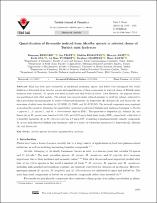| dc.contributor.author | Erenler, Ramazan | |
| dc.contributor.author | Telci, İsa | |
| dc.contributor.author | Elmastaş, Mahfuz | |
| dc.contributor.author | Akşit, Hüseyin | |
| dc.contributor.author | Gül, Fatih | |
| dc.contributor.author | Tüfekçi, Ali Rıza | |
| dc.contributor.author | Demirtaş, İbrahim | |
| dc.contributor.author | Kayır, Ömer | |
| dc.date.accessioned | 2019-05-13T09:02:50Z | |
| dc.date.available | 2019-05-13T09:02:50Z | |
| dc.date.issued | 2018 | |
| dc.identifier.citation | Erenler, R., Telci, İ., Elmastaş, M., Akşit, H., Gül, F., Tüfekçi, A. R., Demirtaş, İ., Kayır, Ö. (2018). Quantification of flavonoids isolated from Mentha spicata in selected clones of Turkish mint landraces. Turkish Journal of Chemistry, 42(6), 1695-1705 | en_US |
| dc.identifier.issn | 1300-0527 | |
| dc.identifier.uri | https://doi.org/10.3906/kim-1712-3 | |
| dc.identifier.uri | https://hdl.handle.net/11491/1342 | |
| dc.description.abstract | Mint has been used extensively in traditional medicines, spices, and herbal teas throughout the world. Isolation of flavonoids from Mentha spicata and quantification of these compounds in selected clones of Turkish mints landraces were achieved. M. spicata was dried in shade and then boiled in water. After filtration, the aqueous extract was partitioned with ethyl acetate. The solvent was removed under reduced pressure to yield the extract, subjected to silica gel column chromatography to isolate 5-demethyl sinensetin (1), hesperidin (2), didymin (3), and linarin (4), the structures of which were elucidated by 1D NMR, 2D NMR, and LC-TOF/MS. The isolated compounds were employed as standard flavonoids to determine the quantitative variations in cultivated Turkish mint landraces belonging to Mentha × piperita L., M. spicata L., and M. × villosonervata Opiz by HPLC. The quantities of hesperidin (2), didymin (3), and linarin (4) in M. spicata were found as 11.83, 3.85, and 42.21 mg/g dried plant weight (DW), respectively, while that of 5-demethyl sinensetin (1) in M. villosonervata was 2.9 mg/g DW. Consisting of pharmaceutically valuable compounds, M. spicata and cultivated Turkish mint landraces could be a source of 5-demethyl sinensetin (1), hesperidin (2), didymin (3), and linarin (4). © TÜBİTAK. | en_US |
| dc.language.iso | eng | |
| dc.publisher | TÜBİTAK | en_US |
| dc.relation.isversionof | 10.3906/kim-1712-3 | en_US |
| dc.rights | info:eu-repo/semantics/openAccess | en_US |
| dc.rights | Attribution 4.0 International (CC BY 4.0) | * |
| dc.rights.uri | https://creativecommons.org/licenses/by/4.0/ | * |
| dc.subject | Flavonoid | en_US |
| dc.subject | Isolation | en_US |
| dc.subject | Mentha Species | en_US |
| dc.subject | Quantification | en_US |
| dc.title | Quantification of flavonoids isolated from Mentha spicata in selected clones of Turkish mint landraces | en_US |
| dc.type | article | en_US |
| dc.relation.journal | Turkish Journal of Chemistry | en_US |
| dc.department | Rektörlük | en_US |
| dc.authorid | 0000-0002-4091-9033 | en_US |
| dc.identifier.volume | 42 | en_US |
| dc.identifier.issue | 6 | en_US |
| dc.identifier.startpage | 1695 | en_US |
| dc.identifier.endpage | 1705 | en_US |
| dc.relation.publicationcategory | Makale - Uluslararası Hakemli Dergi - Kurum Öğretim Elemanı | en_US |



















